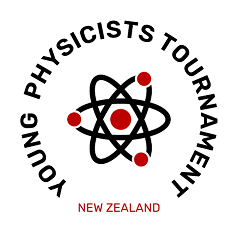2020 NZ Tournament Details
Regional NZYPT tournaments will be held in Auckland, Wellington and Christchurch on:
Saturday 7th March 2020.
- Auckland: TBA
- Wellington: Victoria University
- Christchurch: University of Canterbury
National finals will be held on Saturday 21st March 2020.
The New Zealand Young Physicist’s Tournament offers the challenge and intrigue that can motivate students to reach for their full potential and find out just what they are capable of.
New Zealand has consistently performed at the highest level in the tournament with teams returning with medals every year since 2005. In 2016, 2017 and 2019 the NZ team won silver medals.
If you have not participated in this competition before, the best way to get an idea of what it’s all about is to go along to one of the regional tournaments, usually held early in March (or the national final if it is in your region) and have a look for yourself. It can be difficult to explain, it doesn’t make total sense until you see it in action for yourself. You could talk to teachers or students who have participated before. Of course you could always just jump in and have a go! Whatever happens you and your team are guaranteed to have a lot of fun and learn a LOT!
Please take a look at the International website using the links on the left to view videos of a Physics Fight and to see a model presentation.
Regional tournaments will be held in Auckland, Wellington and Christchurch. Each of these tournaments comprise three rounds called “Physics Fights”. In each Physics Fight teams perform the roles of Reporter and Opponent.
The Regional Competition – A Brief Outline
NZYPT is a tournament for teams of 3 secondary school students. The teams each have to come up with solutions to 7 complex physical problems which are available to the teams for about 8 months before the regional tournament.
The tournament itself takes the form of a series of ‘Physics Fights’. During a Physics Fight at the regional tournament one team (the reporting team) is challenged to present their pre-prepared solution to one of the problems by another team (the opposing team). One member of the reporting team will give a 12 minute presentation of their solution. One member of the opposing team will then discuss the report with the reporter for up to 15 minutes, trying to point out flaws in the report while the reporter defends their work. Issues discussed could be to do with physical understanding, experimental techniques, unexplained trends in the data, unexplored parameters, etc. A jury panel then has the opportunity to question both the reporter and opponent before individually grading the performance of the reporter and opponent.
NZYPT is the selection event for the New Zealand team that may compete in the international tournament. The best five students will form the New Zealand squad from which the 5 person New Zealand team will be selected.
The top teams from each regional tournament proceed to the National Final. Parents and students are asked to note the details regarding NZ Team Selection.
Further details regarding the conduct of these Physics Fights can be found in the IYPT New Zealand Regulations.
Preparation
Prior to the tournament team members will have prepared the solutions to a series of complex Physics problems. For the IYPT New Zealand tournament there is a choice of seven problems. Ideally solutions to all seven problems would be prepared by the team, although it is possible to pass on two problems. For the International tournament there are seventeen problems to prepare.
In a Physics Fight, there are three teams present, each of which will assume one of three roles: the Reporter who presents their solution to a problem, the Opponent who challenges the Reporter to demonstrate their solution and the Reviewer who summarizes and evaluates the arguments from the other two sides. The fight proceeds as a round robin, with each team assuming all of the roles.
During the fight, the jury sits at the back of the room. The size of the jury ranges from five to seven.
The reporting team has one minute to decide if it wants to accept the challenge. A team can reject a challenge, but after the first two rejections, points will be deducted from the final score.
The reporting team has five minutes to prepare their response to the problem. The team members can communicate only with each other during the entire fight.
A single member makes an oral presentation of the solution to the problem, incorporating the theoretical background to the problem and experimental evidence for the solution. Twelve minutes are allowed for making the presentation, using Powerpoint and a projector.
After the presentation, a member of the opposing team has two minutes to briefly ask questions of the reporter, and after three minutes of preparation, engages the reporter in a debate about the presented solution. The opponent can take up to five minutes to present the case against the reporter, and the remaining time to a total of fifteen minutes is in the form of a debate, with the opponent discussing the validity of the reporter’s presentation.
The fight continues with the roles of reporter, opponent and reviewer switched until each team performs all three roles. The reporter’s average score is multiplied by a coefficient of 3.0, the opponent’s by a coefficient of 2.0.
Watch the 2017 World Finals below
